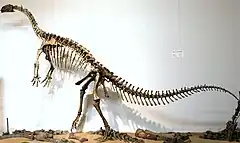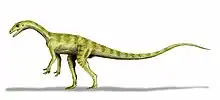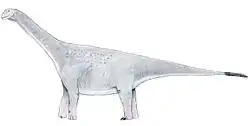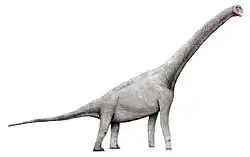| Plateosaurians Temporal range: Late Triassic-Late Cretaceous, | |
|---|---|
 | |
| Plateosaurus engelhardti skeleton | |
| Scientific classification | |
| Domain: | Eukaryota |
| Kingdom: | Animalia |
| Phylum: | Chordata |
| Clade: | Dinosauria |
| Clade: | Saurischia |
| Clade: | †Sauropodomorpha |
| Clade: | †Bagualosauria |
| Clade: | †Plateosauria Tornier, 1913 |
| Subgroups | |
Plateosauria is a clade of sauropodomorph dinosaurs which lived during the Late Triassic to the Late Cretaceous. The name Plateosauria was first coined by Gustav Tornier in 1913.[1] The name afterwards fell out of use until the 1980s.
Classification
Plateosauria is a node-based taxon. In 1998, Paul Sereno defined Plateosauria as the last common ancestor of Plateosaurus engelhardti and Massospondylus carinatus, and its descendants.[2] Peter Galton and Paul Upchurch in 2004 used a different definition: the last common ancestor of Plateosaurus engelhardti and Jingshanosaurus xinwaensis, and its descendants. In their cladistic analysis the Plateosauria belonged to the Prosauropoda, and included the Plateosauridae subgroup. In Galton's and Upchurch's study also Coloradisaurus, Euskelosaurus, Jingshanosaurus, Massospondylus, Mussaurus, Sellosaurus, and Yunnanosaurus proved to be plateosaurians.[3]
However, recent cladistic analyses suggest that the Prosauropoda as traditionally defined is paraphyletic to sauropods.[4][5][6][7][8] Prosauropoda, as currently defined, is a synonym of Plateosauridae as both contain the same taxa by definition. The most recent phylogenetic analysis[9] recovered Issi and Plateosaurus as the basal-most plateosaurs.
The following cladogram simplified after an analysis presented by Apaldetti and colleagues in 2011.[8]
| Plateosauria |
| ||||||||||||||||||||||||||||||||||||||||||||||||
The following cladogram simplified after an analysis presented by Blair McPhee and colleagues in 2014.[10]
| Plateosauria |
| |||||||||||||||||||||||||||||||||||||||||||||
References
- ↑ Tornier, G., 1913, "Reptilia (Paläontologie)" In: Handwörterbuch Naturwissenschaften 8: 337-376
- ↑ Sereno, P.C. (1998). "A rationale for phylogenetic definitions, with applications to the higher-level taxonomy of Dinosauria". Neues Jahrbuch für Geologie und Paläontologie, Abhandlungen. 210: 41–83. doi:10.1127/njgpa/210/1998/41.
- ↑ Galton, P.M & Upchurch, P. (2004). "Prosauropoda". In D. B. Weishampel, P. Dodson, & H. Osmólska (Eds.), the Dinosauria (Second edition). University of California Press, Berkeley: 232–258.
- ↑ Yates, Adam M. (2003). "Species taxonomy of the sauropodomorph dinosaurs from the Löwenstein Formation (Norian, Late Triassic) of Germany". Palaeontology. 46 (2): 317–337. doi:10.1111/j.0031-0239.2003.00301.x. S2CID 86801904.
- ↑ Yates, Adam M. (2007). Barrett, Paul M.; Batten, David J. (eds.). "The first complete skull of the Triassic dinosaur Melanorosaurus Haughton (Sauropodomorpha: Anchisauria)". Evolution and Palaeobiology. 77: 9–55. ISBN 978-1-4051-6933-2.
- ↑ Pol D.; Garrido A.; Cerda I.A. (2011). "A New Sauropodomorph Dinosaur from the Early Jurassic of Patagonia and the Origin and Evolution of the Sauropod-type Sacrum". PLOS ONE. 6 (1): e14572. Bibcode:2011PLoSO...614572P. doi:10.1371/journal.pone.0014572. PMC 3027623. PMID 21298087.
- ↑ Fernando E. Novas; Martin D. Ezcurra; Sankar Chatterjee; T. S. Kutty (2011). "New dinosaur species from the Upper Triassic Upper Maleri and Lower Dharmaram formations of central India". Earth and Environmental Science Transactions of the Royal Society of Edinburgh. 101 (3–4): 333–349. doi:10.1017/S1755691011020093. S2CID 128620874.
- 1 2 Cecilia Apaldetti; Ricardo N. Martinez; Oscar A. Alcober; Diego Pol (2011). "A New Basal Sauropodomorph (Dinosauria: Saurischia) from Quebrada del Barro Formation (Marayes-El Carrizal Basin), Northwestern Argentina". PLOS ONE. 6 (11): e26964. Bibcode:2011PLoSO...626964A. doi:10.1371/journal.pone.0026964. PMC 3212523. PMID 22096511.
- ↑ Beccari, Victor; Mateus, Octávio; Wings, Oliver; Milàn, Jesper; Clemmensen, Lars B. (November 2021). "Issi saaneq gen. et sp. nov.—A New Sauropodomorph Dinosaur from the Late Triassic (Norian) of Jameson Land, Central East Greenland". Diversity. 13 (11): 561. doi:10.3390/d13110561. hdl:10362/128951.
- ↑ McPhee, B. W.; Yates, A. M.; Choiniere, J. N.; Abdala, F. (2014). "The complete anatomy and phylogenetic relationships of Antetonitrus ingenipes(Sauropodiformes, Dinosauria): Implications for the origins of Sauropoda". Zoological Journal of the Linnean Society. 171: 151–205. doi:10.1111/zoj.12127. S2CID 82631097.










